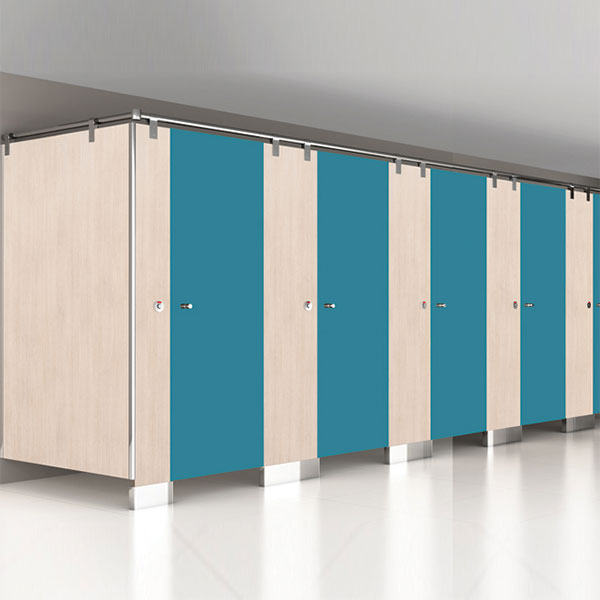The Modern Solution for Public and Private Spaces

Toilet cubicles have become an essential component of modern architecture and design, particularly for public and commercial spaces. From offices to shopping malls, and schools to airports, toilet cubicles ensure privacy, efficiency, and aesthetic appeal. In this blog, we’ll explore the key features, materials, and benefits of toilet cubicles, as well as some trends shaping the future of this vital space.
What Are Toilet Cubicles?
Toilet cubicles are partitioned enclosures designed to provide privacy in shared washroom areas. They consist of individual stalls or compartments, separated by walls or panels, typically installed in commercial or public restrooms. These cubicles offer a practical solution for optimizing space while ensuring that users have the privacy they need.
Key Benefits of Toilet Cubicles
Space Efficiency Toilet cubicles are designed to maximize space usage, especially in high-traffic areas. By dividing the restroom into individual stalls, these cubicles make it possible to accommodate multiple users simultaneously in a smaller footprint, without sacrificing comfort.
Privacy and Hygiene Privacy is the primary function of toilet cubicles, ensuring that users feel comfortable while using shared facilities. In addition to privacy, modern toilet cubicles are designed with hygiene in mind. High-quality materials such as phenolic, HPL (High-Pressure Laminate), and stainless steel prevent the growth of bacteria and are easy to clean.
Cost-Effective Installing toilet cubicles is a cost-effective solution for businesses and institutions. Compared to building individual bathrooms, cubicles reduce construction and maintenance costs. Their modular design also allows for easy replacements and updates when necessary.
Customizable Design Toilet cubicles can be customized to match the aesthetic of any space. From minimalist and modern to luxurious and decorative, various colors, materials, and finishes can be tailored to suit different environments, creating a cohesive design within the building.
Types of Toilet Cubicles
Standard Toilet Cubicles Standard toilet cubicles are common in places like shopping malls, office buildings, and schools. They offer basic functionality and are usually constructed from durable materials that withstand heavy usage.
Executive or High-End Cubicles Executive cubicles are more refined, featuring enhanced privacy and comfort. These are often used in luxury hotels, high-end offices, and VIP areas, where appearance and exclusivity are priorities.
Accessible Toilet Cubicles To meet accessibility standards, these cubicles are designed to accommodate individuals with disabilities. They are larger, equipped with grab bars, and sometimes feature automatic doors, lower sinks, and toilets for easy access.
Shower Cubicles Shower cubicles are common in gyms, swimming pools, and health clubs. They provide private spaces for individuals to shower, with waterproof panels and appropriate drainage systems.
Changing Room Cubicles Used in retail stores, gyms, and swimming pools, these cubicles offer private changing areas. They often feature benches, hooks, and shelves for comfort and convenience.
Materials Used in Toilet Cubicles
Choosing the right material for toilet cubicles is essential for durability, hygiene, and aesthetics. Here are some commonly used materials:
High-Pressure Laminate (HPL) HPL is widely used for toilet cubicles due to its durability, moisture resistance, and ease of cleaning. It comes in a wide range of colors and patterns, making it a popular choice for customizable designs.
Solid Grade Laminate (SGL) SGL is a more durable and waterproof version of HPL. It is ideal for high-traffic environments such as schools, airports, and public restrooms, where strength and resistance to impact are crucial.
Stainless Steel Stainless steel cubicles are synonymous with elegance and durability. They are often used in luxury environments due to their sleek appearance, resistance to corrosion, and ability to maintain hygiene.
Glass Glass cubicles are used in premium settings where transparency and light are desired. Usually frosted for privacy, glass cubicles offer a modern and luxurious feel to high-end washrooms.
Phenolic Resin Phenolic cubicles are made from layers of paper or fabric impregnated with resin. These are highly durable and resistant to moisture, making them ideal for wet areas like swimming pools and gyms.
Modern Trends in Toilet Cubicles
As design and technology evolve, toilet cubicles are also adapting to modern needs and expectations. Here are some trends shaping the future of this space:
Sustainability Eco-friendly materials and energy-efficient designs are becoming increasingly popular. Recycled materials, water-saving technologies, and smart lighting systems are integrated into modern cubicle designs to minimize environmental impact.
Smart Cubicles With the rise of smart buildings, toilet cubicles are also getting smarter. Touchless doors, automated cleaning systems, and occupancy sensors are some examples of technology making its way into modern toilet cubicles.
Acoustic Privacy Incorporating soundproof materials and construction techniques ensures a quieter and more private experience within the cubicle. This is particularly important in high-end settings like offices and hotels.
Compact and Modular Design As urban spaces become more limited, compact and modular cubicle designs are becoming popular. These cubicles can be installed in smaller spaces without compromising functionality and privacy.
Inclusive Design Inclusive design principles are gaining prominence in modern cubicle design. This includes the use of gender-neutral cubicles, accessible cubicles for people with disabilities, and designs that cater to all age groups.
Conclusion
Toilet Cubicle Manufacturer are a fundamental aspect of modern architecture, providing functional and aesthetic solutions for private and public restrooms. With the variety of materials and designs available today, businesses and institutions can find toilet cubicles that not only meet their functional needs but also enhance the overall appearance of their space. As sustainability, technology, and inclusivity continue to shape the industry, toilet cubicles are set to become even more efficient, innovative, and user-fri







